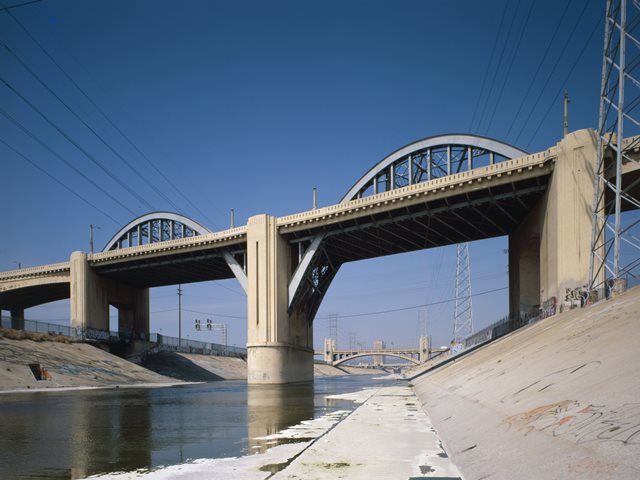We Recommend:
Bach Steel - Experts at historic truss bridge restoration.
BridgeHunter.com Phase 1 is released to the public! - Visit Now
6th Street Viaduct
6th Street Bridge

Primary Photographer(s): Historic American Engineering Record
Bridge Documented: August 6, 2019
6th Street (Whittier Boulevard) Over Los Angeles River and Various Roads and Railroads
Los Angeles: Los Angeles County, California: United States
Metal Hingeless Solid Ribbed Through Arch, Fixed and Approach Spans: Concrete Continuous T-Beam, Fixed
1932 By Builder/Contractor: Virginia Bridge and Iron Company of Roanoke, Virginia and J. F. Knapp of Oakland, California and Engineer/Design: Merrill Butler
Not Available or Not Applicable
150.0 Feet (45.7 Meters)
2,959.0 Feet (901.9 Meters)
46 Feet (14.02 Meters)
1 Main Span(s) and 39 Approach Span(s)
53C1880

View Information About HSR Ratings
Bridge Documentation
This bridge no longer exists!
Bridge Status: Demolished and replaced starting in 2016.This bridge was unique, with its long, sweeping approach spans that led to distinctive, skewed steel arch spans positioned to accommodate a curve of the roadway. The steel arch spans were also unique for the fact that the arch ribs were longer at the center pier, reaching further down below the roadway to the pier than on the outer piers. The bridge was richly ornamented with handsomely decorated railings and other concrete detailing on the approaches.
This bridge was one of the most filmed bridges in the United States. The bridge appeared in countless movies, car commercials, and even in video games. The bridge was particularly a favorite for car commercials, where the beautiful steel through arches complimented whatever vehicle was shown driving over the bridge.
The demolition and replacement of this bridge represents the loss of one of the most significant and famous bridges in California. It is deeply disturbing that this bridge was completely demolished and replaced, and shows a strong lack of concern for historic preservation on the part of the city. The city claimed that the bridge could not be preserved because the concrete in this bridge (unlike other nearby historic concrete bridges) was faulty and had developed an alkali silica reaction (ASR) which resulted in severe deterioration of the concrete. On this basis, the city claimed, the bridge could not be preserved. Indeed, this may be true for the concrete t-beam approach systems of this bridge. But take a look at the main spans of the historic bridge. They were constructed of a material called... steel! Steel is different from concrete and does not suffer from alkali silica reactions. As the main spans of the bridge, these steel spans were the most important and iconic parts of the bridge. They could have and should have been preserved, even if this required the reconstruction of the concrete piers supporting them. This process would have been feasible if there had been a genuine interest in preserving the heritage of the city. With the steel arch spans preserved, the approaches could have been replaced using modern concrete. This bridge is a perfect example of the truth about historic bridge preservation in the United States. Preservation is a choice, and if the desire to preserve this nation's transportation heritage is genuine, than solutions can be found, even if they involve compromise. For this bridge, preserving the steel main spans while replacing the defective concrete approach spans would have been one example of a preservation compromise. However, sadly, in the United States most often compromise is thrown to the wind in favor of total demolition and replacement. The loss of this bridge is a scar on the landscape because it was one of a group of bridges built in the early 20th century, and its loss is also a testiment to the lack of willingness to compromise to find a preservation solution.
View Archived National Bridge Inventory Report - Has Additional Details and Evaluation
View Historic American Engineering Record (HAER) Documentation For This Bridge
HAER Drawings, PDF - HAER Data Pages, PDF - HAER
Above: Historical photo showing bridge construction.
![]()
Photo Galleries and Videos: 6th Street Viaduct
Bridge Photo-Documentation
Original / Full Size PhotosA collection of overview and detail photos. This gallery offers photos in the highest available resolution and file size in a touch-friendly popup viewer.
Alternatively, Browse Without Using Viewer
![]()
Bridge Photo-Documentation
Mobile Optimized PhotosA collection of overview and detail photos. This gallery features data-friendly, fast-loading photos in a touch-friendly popup viewer.
Alternatively, Browse Without Using Viewer
![]()
Maps and Links: 6th Street Viaduct
This historic bridge has been demolished. This map is shown for reference purposes only.
Coordinates (Latitude, Longitude):
Search For Additional Bridge Listings:
Bridgehunter.com: View listed bridges within 0.5 miles (0.8 kilometers) of this bridge.
Bridgehunter.com: View listed bridges within 10 miles (16 kilometers) of this bridge.
Additional Maps:
Google Streetview (If Available)
GeoHack (Additional Links and Coordinates)
Apple Maps (Via DuckDuckGo Search)
Apple Maps (Apple devices only)
Android: Open Location In Your Map or GPS App
Flickr Gallery (Find Nearby Photos)
Wikimedia Commons (Find Nearby Photos)
Directions Via Sygic For Android
Directions Via Sygic For iOS and Android Dolphin Browser
USGS National Map (United States Only)
Historical USGS Topo Maps (United States Only)
Historic Aerials (United States Only)
CalTopo Maps (United States Only)


